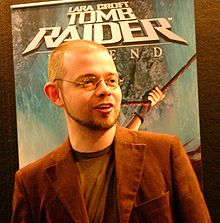Tomb Raider, also known as Lara Croft: Tomb Raider from 2001 to 2008, is a media franchise that originated with an action-adventure video game series created by British gaming company Core Design. Formerly owned by Eidos Interactive, then by Square Enix Europe after Square Enix's acquisition of Eidos in 2009, the franchise focuses on the fictional British archaeologist Lara Croft, who travels around the world searching for lost artefacts and infiltrating dangerous tombs and ruins. Gameplay generally focuses on exploration of environments, solving puzzles, navigating hostile environments filled with traps, and fighting enemies. Additional media has been developed for the franchise in the form of film adaptations, comics and novels. On January 27, 2023, The Hollywood Reporter exclusively reported that Amazon was in the works with Phoebe Waller-Bridge reportedly set to write a TV Show adaptation of the video game franchise. It was also reported this would involve a tie-in video game and movie in an interconnected universe, likened to the Marvel Cinematic Universe.

Lara Croft is a fictional character and the main protagonist of the video game franchise Tomb Raider. She is presented as a highly intelligent and athletic British archaeologist who ventures into ancient tombs and hazardous ruins around the world. Created by a team at British developer Core Design that included Toby Gard, the character first appeared in the video game Tomb Raider in 1996.

Lara Croft: Tomb Raider – The Cradle of Life is a 2003 action adventure film directed by Jan de Bont and based on the Tomb Raider video game series. Angelina Jolie stars as the titular character Lara Croft with supporting performances from Gerard Butler, Ciarán Hinds, Chris Barrie, Noah Taylor, Til Schweiger, Djimon Hounsou and Simon Yam. An international co-production between the United States, the United Kingdom, Germany and Japan, the film is a sequel to the 2001 film Lara Croft: Tomb Raider.
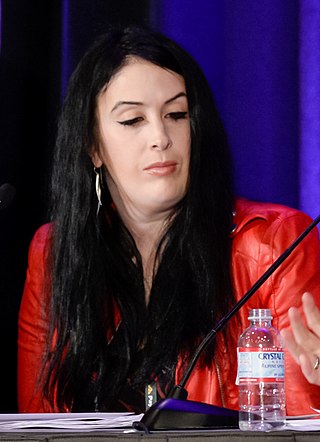
Rhianna Pratchett is an English video game writer and journalist. She has worked on Heavenly Sword (2007), Overlord (2007), Mirror's Edge (2008) and Tomb Raider (2013) and its follow up, Rise of the Tomb Raider (2015), among others. She is the daughter of fantasy writer Terry Pratchett.

Core Design Limited was a British video game developer based in Derby. Founded in May 1988 by former Gremlin Graphics employees, it originally bore the name Megabrite until rebranding as Core Design in October the same year. The company was acquired by umbrella company CentreGold in December 1994, which in turn was acquired by Eidos Interactive in April 1996. In May 2006, the Core Design personnel and assets were acquired by Rebellion Developments, and the company became Rebellion Derby, which was then shut down in March 2010.

Tomb Raider Chronicles is an action-adventure platform video game developed by Core Design and published in 2000 by Eidos Interactive for PlayStation, Microsoft Windows and Dreamcast. Following Tomb Raider: The Last Revelation, series protagonist Lara Croft is presumed dead, and a group of friends attend a memorial service at her home to recount tales of her earlier exploits. Gameplay follows Lara through linear levels, solving puzzles and fighting enemies. Some levels incorporate additional gameplay elements such as stealth.

Tomb Raider: The Last Revelation is an action-adventure video game developed by Core Design and published by Eidos Interactive. It was first released for PlayStation and Microsoft Windows in 1999, then on Dreamcast and Mac OS the following year. It is the fourth instalment in the Tomb Raider series. The narrative follows archaeologist-adventurer Lara Croft as she races to imprison the Egyptian god Set after accidentally setting him free. Gameplay features Lara navigating levels split into multiple areas and room complexes, fighting enemies and solving puzzles to progress.

Tomb Raider III: Adventures of Lara Croft is an action-adventure video game developed by Core Design and published by Eidos Interactive. It was released for the PlayStation and Microsoft Windows platforms in 1998. Tomb Raider III is the third title in the Tomb Raider series and a sequel to Tomb Raider II. The story of the game follows archaeologist-adventurer Lara Croft as she embarks upon a quest to recover four pieces of a meteorite that are scattered across the world. To progress through the game, the player must complete a series of levels that involve solving puzzles, traversing dangerous locations, and defeating enemies.
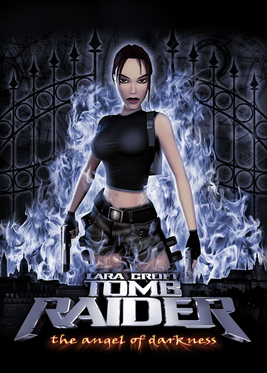
Tomb Raider: The Angel of Darkness is a 2003 action-adventure game developed by Core Design and published by Eidos Interactive for PlayStation 2 and Microsoft Windows. A Mac OS X port was developed by Beenox and published by Aspyr the same year. Acting as a direct sequel to Tomb Raider: The Last Revelation and Tomb Raider Chronicles, the storyline follows Lara Croft as she attempts to clear herself of being the suspect of her former mentor Werner Von Croy's murder while investigating the activities of a black magic cult. The gameplay follows series tradition, with Lara navigating platforming environments while incorporating stealth and character growth elements.
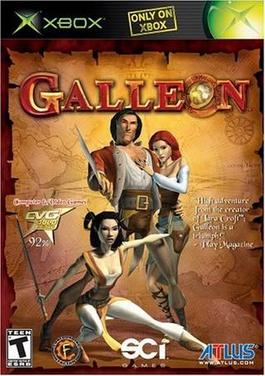
Galleon is a 2004 action-adventure game developed by Confounding Factor and published by SCi Games and Atlus for the Xbox. Designed by Toby Gard as his first independent project after leaving Core Design, the game was announced in 1997, but suffered several delays and changes in the consoles it would be released to. It was released in Europe on June 11, 2004, and in North America on August 3 to mixed reviews from critics. A mobile spin-off entitled Galleon: Dawn was released on August 26, 2004.

Tomb Raider: Legend is an action-adventure video game developed by Crystal Dynamics and published by Eidos Interactive. It is the seventh main entry in the Tomb Raider series and a reboot of the series that reimagined the origins and character of series protagonist Lara Croft. The game was released in 2006 for Microsoft Windows, PlayStation 2, Xbox, Xbox 360, PlayStation Portable, GameCube, Game Boy Advance, Nintendo DS, and mobile phones. A PlayStation 3 port was released in 2011 as part of The Tomb Raider Trilogy.

Tomb Raider is a 1996 action-adventure video game developed by Core Design and published by Eidos Interactive. It was first released on the Sega Saturn, followed shortly by versions for MS-DOS and the PlayStation. Later releases came for Mac OS (1999), Pocket PC (2002), N-Gage (2003), iOS (2013) and Android (2015). It is the debut entry in the Tomb Raider media franchise. The game follows archaeologist-adventurer Lara Croft, who is hired by businesswoman Jacqueline Natla to find an artefact called the Scion of Atlantis. Gameplay features Lara navigating levels split into multiple areas and room complexes while fighting enemies and solving puzzles to progress.

Tomb Raider: Anniversary is an action-adventure video game co-developed by Crystal Dynamics and Buzz Monkey Software. It was published by Eidos Interactive in 2007 for Microsoft Windows, PlayStation 2, Xbox 360, PlayStation Portable, Wii and mobile phones. It was later ported to OS X in 2008 and PlayStation 3 in 2011. The eighth overall entry in the Tomb Raider series and second in the Legend trilogy, Anniversary is a remake of the first Tomb Raider game, originally released in 1996.

Tomb Raider is an action-adventure video game developed by Core Design and released for the Game Boy Color by THQ under license from Eidos Interactive in 2000. A sequel, Tomb Raider: Curse of the Sword, was released in 2001.

Revisioned: Tomb Raider is a ten-part animated series created by Ricardo Sanchez and based on the Tomb Raider series. It was released on the Turner Broadcasting's online video game service GameTap from July 10 to November 13, 2007. The series consists of various animation and comic book talents' renditions of Lara Croft, presented in the form of animated episodes. Minnie Driver voices Lara Croft in all episodes. The first three episodes present a linked story arc called "Keys to the Kingdom". Other episodes tell stories of single or multiple episodes that function as an anthology. The art style and storytelling vary in each episode depending on the writer and designer.

Tomb Raider: Underworld is an action-adventure video game developed by Crystal Dynamics and published by Eidos Interactive for Windows, PlayStation 3, Xbox 360, Wii and Nintendo DS in November 2008. Later versions were released for mobile in December 2008, PlayStation 2 in 2009, and OS X in 2012. Various companies ported or developed the different versions. The ninth overall entry in the Tomb Raider series and third in the Legend trilogy, Underworld follows archaeologist-adventurer Lara Croft as she searches for Mjolnir, an artefact key to entering the realm of Helheim, while confronting adversaries from her past. Gameplay features Lara navigating levels set across the world through platforming, fighting enemies and solving puzzles to progress.

Tomb Raider is a 2013 action-adventure video game developed by Crystal Dynamics and published by Square Enix's European branch. It is the tenth main game in the Tomb Raider franchise and a reboot of the series, acting as the first instalment in the Survivor trilogy that reconstructs the origins of Lara Croft. Tomb Raider was released on 5 March 2013 for Microsoft Windows, PlayStation 3 and Xbox 360. Gameplay focus is on survival, with exploration when traversing the island and visiting various optional tombs. It is the first game in the main series to have multiplayer, the first game in the series to be published by Square Enix, after the latter's acquisition of Eidos Interactive in 2009.

Tomb Raider II is a 1997 action-adventure video game developed by Core Design and published by Eidos Interactive. It was first released on Windows and PlayStation. Later releases came for Mac OS (1998), iOS (2014) and Android (2015). It is the second entry in the Tomb Raider series, and follows archaeologist-adventurer Lara Croft hunting the magical Dagger of Xian, which is also hunted by an Italian cult. Gameplay features Lara navigating levels split into multiple areas and room complexes while fighting enemies and solving puzzles to progress, with some areas allowing for or requiring the use of vehicles. An expansion pack subtitled The Golden Mask was released the following year, containing new levels focused on Lara's quest to find a golden mask in Alaska.
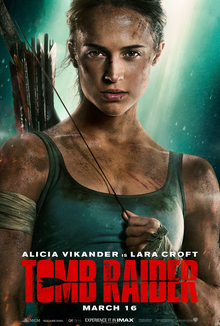
Tomb Raider is a 2018 action-adventure film directed by Roar Uthaug, with a screenplay by Geneva Robertson-Dworet and Alastair Siddons, from a story by Evan Daugherty and Robertson-Dworet. An American and British co-production, it is based on the 2013 video game of the same name, with some elements of its sequel by Crystal Dynamics, a reboot, and the third installment in the Tomb Raider film series. The film stars Alicia Vikander as Lara Croft, who embarks on a perilous journey to her father's last-known destination, hoping to solve the mystery of his disappearance. Dominic West, Walton Goggins, Daniel Wu, and Kristin Scott Thomas appear in supporting roles.
